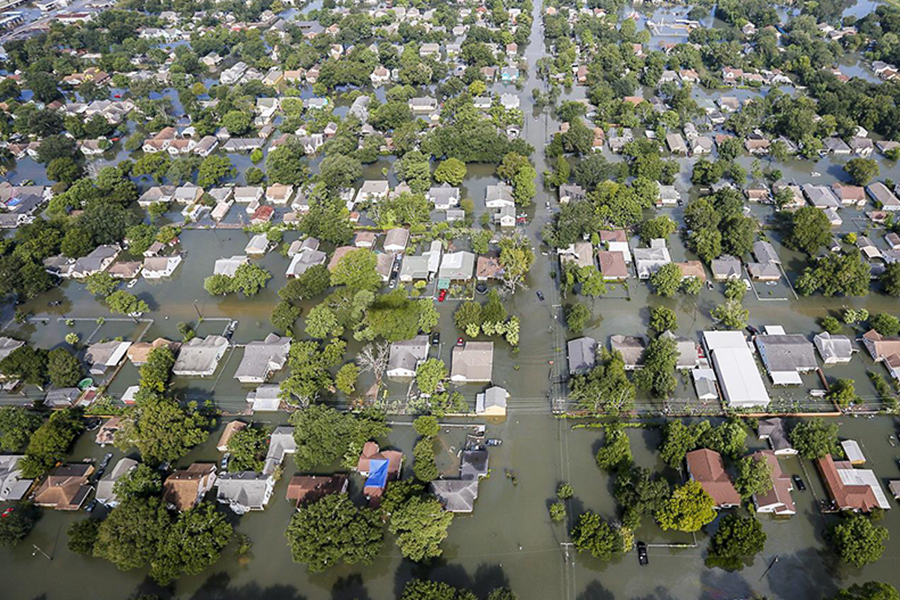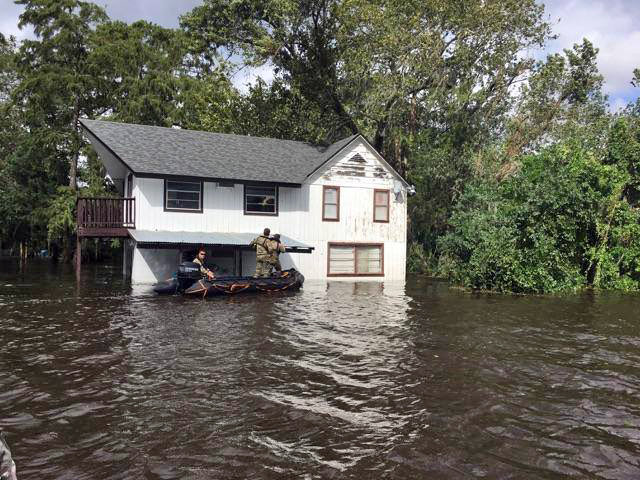Glossary:
FIRM: Flood Insurance Rate Map | SFHA: Special Flood Hazard Area | CRS: Community Rating System | Substantial Damage

Local officials struggle with enforcing where and how people build in flood zones, due to a variety of factors. Better coordination and tools, shared between federal, state and local authorities, could improve flood mitigation enforcement and save money for all involved, according to a new report from Coastal Resilience Center (CRC) researchers.
The report, authored by Dr. Paula Lorente and Jaimie Masterson, of Texas A&M University (TAMU), and Dr. Phil Berke of the University of North Carolina at Chapel Hill, “Research in Support of Floodplain Management Regulations Compliance,” lays out a series of recommendations based on interviews with local officials and a national advisory committee.
The report’s goal is to improve compliance with the National Flood Insurance Program (NFIP) – managed by the Federal Emergency Management Agency (FEMA) – by assessing the challenges and roadblocks that many communities face when enforcing the program’s regulations regarding substantial damages. The NFIP is the main instrument guiding flood mitigation and adaptation in the United States. Its operations are organized around mapping floodplains, issuing flood insurance, developing floodplain management regulations and providing grants for flood mitigation activities.

About substantial damages

To reduce the risks of future flooding, communities participating in the NFIP are required to use the “substantial damage” or “50 percent rule,” which states that structures with repair or remodeling costs that exceed half of the structure’s pre-damaged or pre-remodeled market value must be elevated (above the base flood elevation) or removed from the Special Flood Hazard Area (SFHA).
According to the report’s authors, community officials nationwide have struggled with the implementation and enforcement of this rule, especially after major disasters. Part of the challenge with implementing this rule is that information on a structure’s damage is gathered in pieces, by different people, at different times and for different purposes.
Interviews with local officials

The CRC researchers spoke to officials in 13 small- to medium-sized communities (between 5,000-250,000 people, separated into four population size categories) across Texas, Illinois, Louisiana and North Carolina. Each of these communities in recent years has experienced riverine floods, urban floods, coastal surge, hurricanes and tornadoes, or a combination of those hazards, resulting in substantially damaged structures. Interviewees included floodplain administrators, emergency managers, city managers, appraisers and community planners, among others.
The main purpose of the community interviews was to understand local challenges community officials face when implementing and enforcing the NFIP’s regulations of substantially damaged and substantially improved structures located in SFHAs.

The recommendations
Some of the solutions included in the report involve establishing new and updated databases and tools, while others simply involve better use of existing resources, according to the authors.
“Flood damage assessments involve many procedures and protocols that can be easily misunderstood, ignored, partially-avoided, or manipulated by different stakeholders,” the report’s authors write. “This can position the National Flood Insurance Program (NFIP) to pay future claims on homes that should be (but are not) elevated, rebuilt, demolished, or removed from floodplain areas.”
The report’s recommendations are divided into federal, state and local-level steps, with nine over-arching recommendations offered by a majority of interviewees:
Top priority recommendations ranked by all levels of respondents:
- Create open-data systems to share information on flood insurance policies and damage claims, repetitive loss properties and other key data.
- Require communities to maintain a yearly inventory of structures in SFHAs and include a wide-range of data associated with those structures.
- Provide support for training, travel and per diems to establish a corps of trained professional volunteers for fast deployment in post-disaster environments.
- Develop agreements with federal or other authorities to provide aerial imagery and/or produce high-water mark maps to make data more widely available
- Make sure that non-compliant behavior, however minor, has some kind of consequence. Make sure that major violations result in severe sanctions, such as reductions in CRS scores or greater penalties for repeat violators.
- Improve data-sharing between FEMA and state/local organizations and non-profits that could increase the number of qualified volunteers doing assessments after an event.
- Require state-level mitigation plans to be better connected to NFIP compliance and substantial damage regulations by making states specify how they will build capacity to administer grants and other activity.
- Develop an evaluation training program with instructions on how initiate disaster assessments with little delay, and train officials – particularly floodplain administrators – on the correct actions based on potential disaster scenarios.
- Provide communities with access and training on geospatial software tools (such as GIS mapping) to map high-water marks.
Top priority actions from this list were ranked by compiling input from local officials of participating communities, members of the project’s National Advisory Committee and FEMA staff. Some of the recommendations may require legislation, and others can be implemented by FEMA without much processing or delay, the report’s authors wrote.
“Improving the nation’s resilience to flooding hazards is achievable, and doing so will involve enhanced attention to mitigation program capacity building and greater levels of compliance at all levels of government,” the researchers wrote.

Among the findings was a major gap in the NFIP, the authors note: In many cases, information on flood insurance is not being communicated clearly to residents.
“While most communities indicated that residents in SFHAs are generally aware of flood risks in the area, they also noted that people often underestimate their risk because they do not understand what the ‘100-year floodplain’ means for their investment or how risk changes within and beyond the SFHAs over time,” the authors wrote. “If residents were provided with specific information about the past or potential impacts on their properties, they would likely make different decisions with respect to investments, relocation and flood insurance coverage.”
In other cases, federal and local officials communicate differing information to residents about the minimum regulations for retrofitting properties. For example, some federal officials are not aware of stricter rules some local governments may have adopted.
“As a result, communities face a lot of backlash and political pushback after disasters that often result in the reversal or weakening of local floodplain regulations,” the researchers wrote.
The authors recommend that FEMA agents have access to the most updated information on freeboard requirements and other retrofit regulations to make sure communications are consistent with information from local code enforcement and floodplain administration staff.
“Local governments need more support and capacity to conduct damage assessments and make sure contractors and property owners know floodplain requirements,” Masterson said. “We found that cities within states that are proactive, incentivize planning, and contribute to buyout programs are having an easier time keeping structures out of harms’ way.
The full list of recommendations can be found here.
